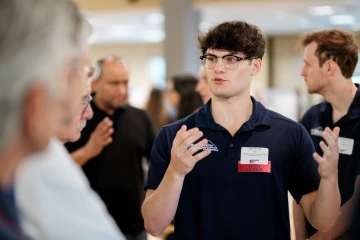BRITE Students Take Top Prize at Craig M. Berge Design Day

Project Title: BRITE: Blinding Resonant Incapacitating Throwable Emitter
Team 22030 Members:
Nathan Leith Busack, project lead, mechanical engineering
Chase Alexander Musick, mechanical engineering
Jeston Nicholas Rusnak, mechanical engineering
Alex St Peter, optical sciences and engineering
Ryan Paul Stancliffe, electrical and computer engineering
Nathaniel E Verdonk, mechanical engineering
Sponsor: Elbit Systems of America
At this year’s Craig M. Berge Design Day, team 22030 won the top prize of $7,500 through preparation and tenacity.
"Did we fail? Totally. But we failed really early, so we were able to correct that," said Alex St Peter, now an optical sciences and engineering graduate.

Jeston Rusnak speaks with the judges.
The team won the Craig M. Berge Dean's Award for Most Outstanding Project for creating a Blinding Resonant Incapacitating Throwable Emitter, or BRITE. Unlike traditional flashbang grenades, which use explosives, BRITE doesn’t cause permanent damage to the person it’s aimed at, and even avoids causing disorientation for users wearing standard eye and ear protection.
Other commercially available electronic flashbangs also stun assailants with a high-pitched noise and a bright light, but BRITE is more powerful than what’s on the market.
The team members created three full prototypes of the device and several dozen prototypes of individual parts. One component that gave them trouble was the battery box, which initially sustained damage when the device was dropped or thrown. It took the team eight to 10 redesigns to find the materials that held up to 6-foot drops onto a hard surface.
They kept at it until they created a model that beat the performance of current models and surpassed their sponsor’s requirements.
“As a team, we stood behind the knowledge we possessed as a group, expanded our understanding in areas we knew little about, and never let any setbacks stop us from completing the project,” said new mechanical engineering graduate Nathan Verdonk in the project video.
The project specifications were conceived by Matthias Whitney, a 2009 optical sciences and engineering graduate and electro optics engineering manager at Elbit Systems of America. Having had his own student experience with an interdisciplinary capstone project, Whitney strove to request an attainable, yet challenging, outcome and allow the students room for discovery.
“I tried to write requirements that would give them freedom of design so they could have a project at the end that was truly their own and not my micromanaged conception of what I wanted,” he said.
This was the company’s fourth year sponsoring an interdisciplinary capstone project. Whitney, who asked his employer to become involved in the program, believes the partnership is increasing name recognition for Elbit Systems at the University of Arizona. He works from the company’s New Hampshire office and makes regular trips to campus to recruit new hires.
As a sponsor mentor, Whitney prioritized providing a good experience for the team by being readily available to answer questions and offer feedback.
“Being able to make that time commitment has made it a success in our eyes so the students can feel like they have an involved sponsor,” he said.
Whitney says the team knocked it out of the park, and that Elbit Systems may pursue using the BRITE technology as a non-lethal landmine.

